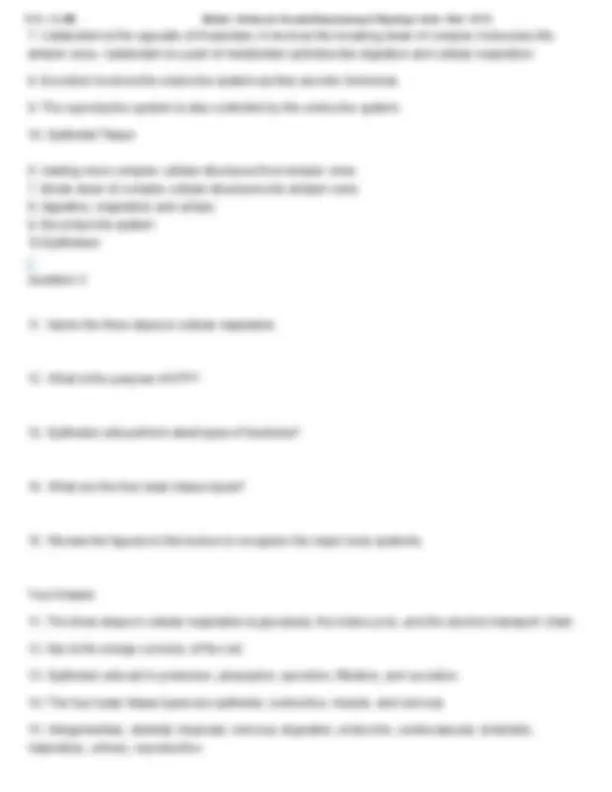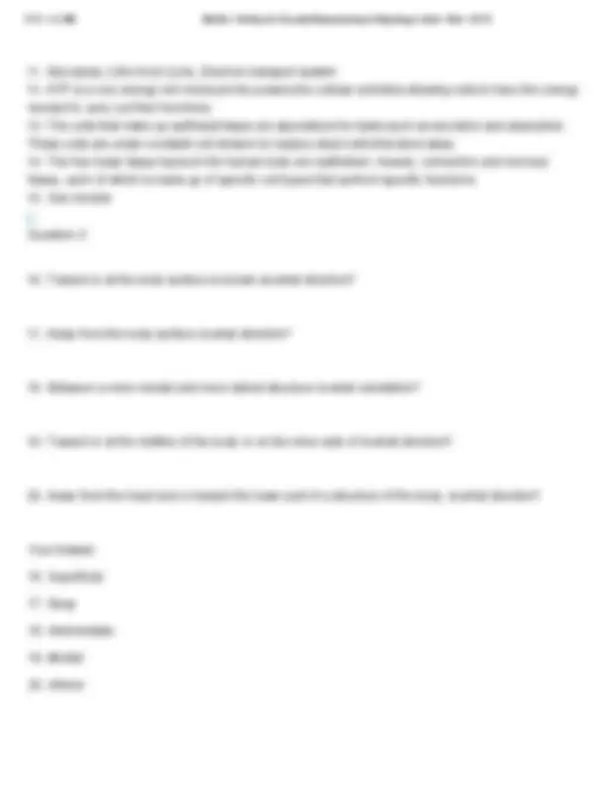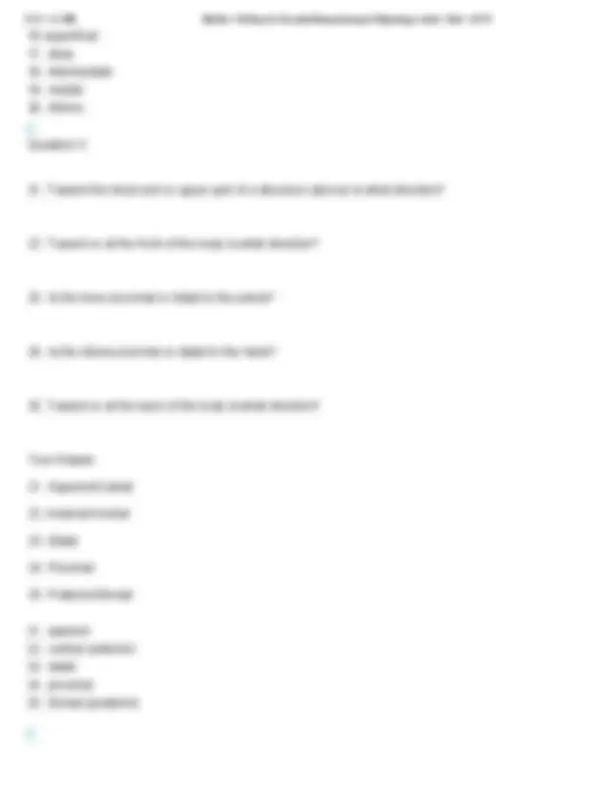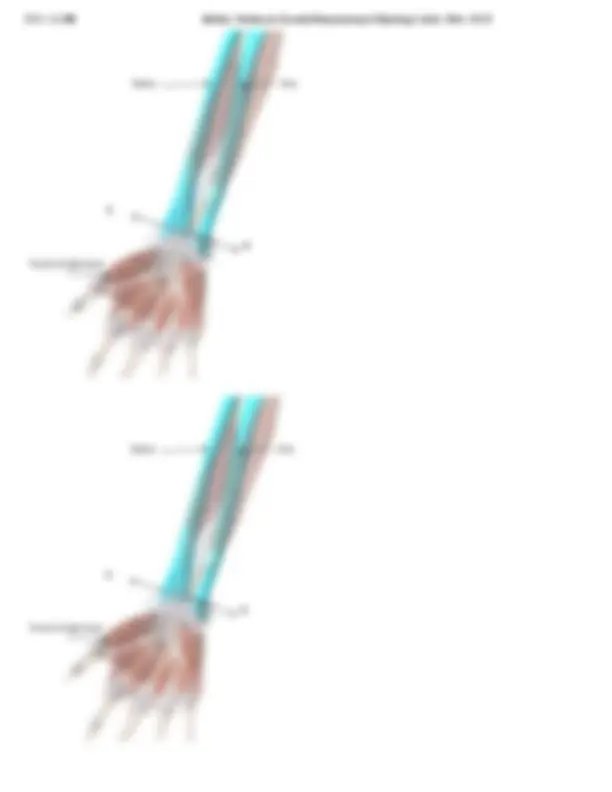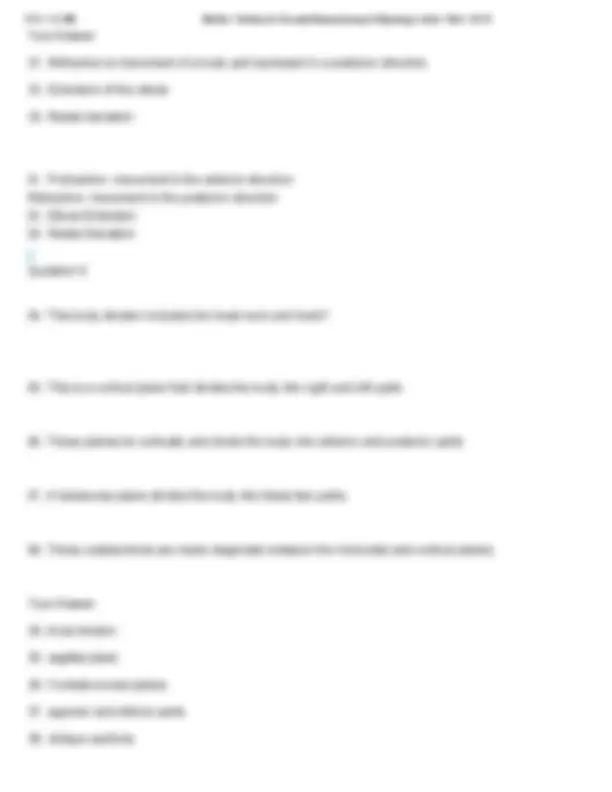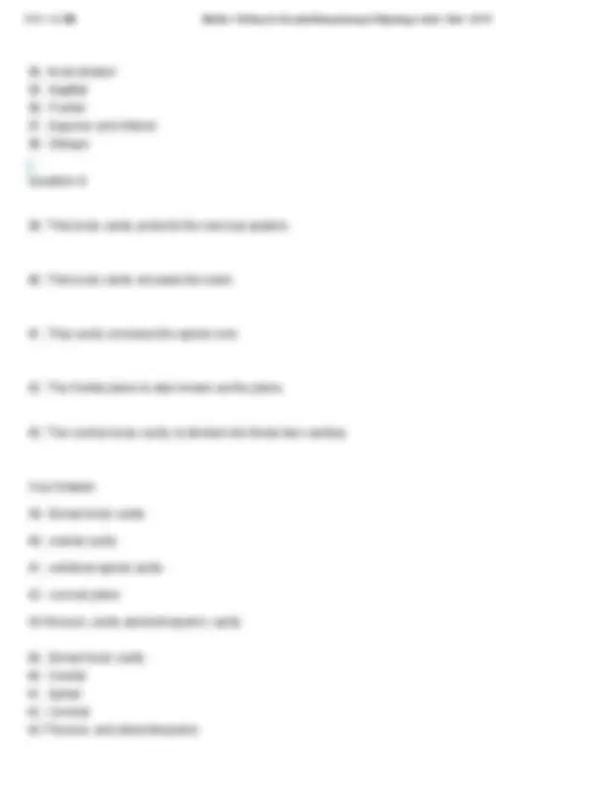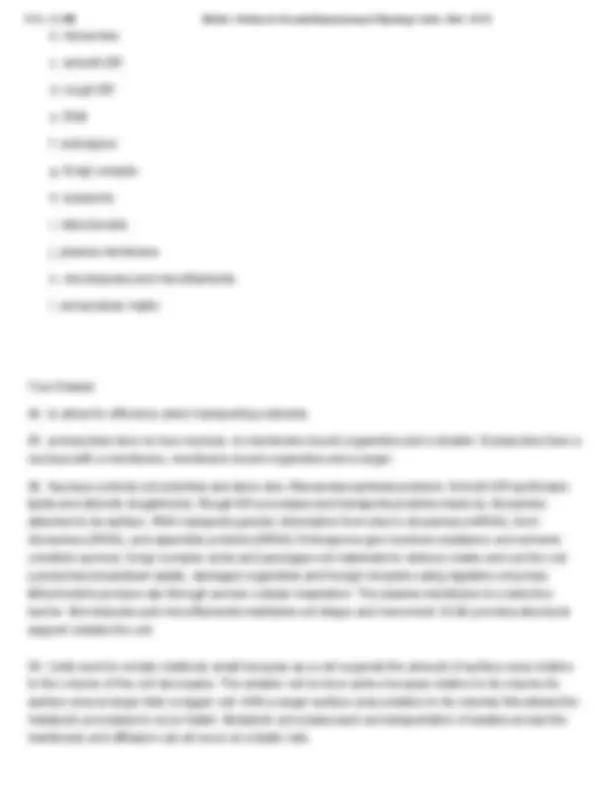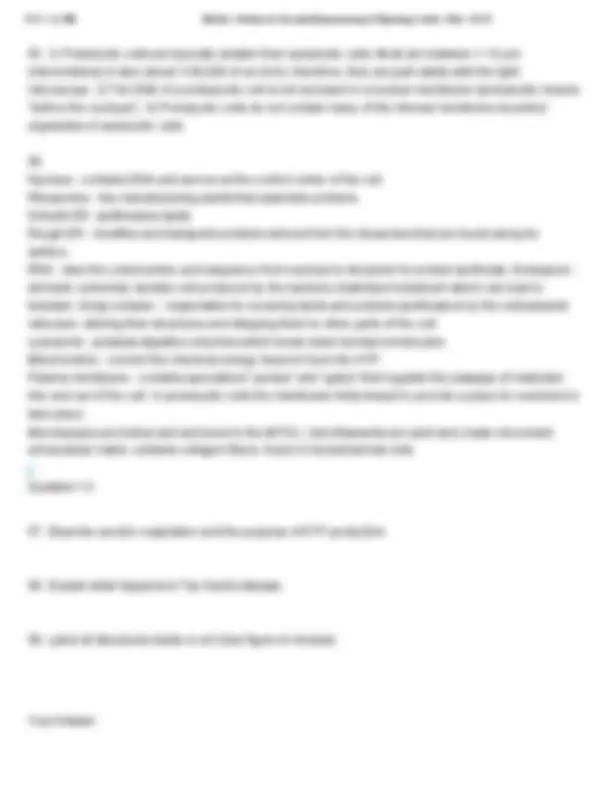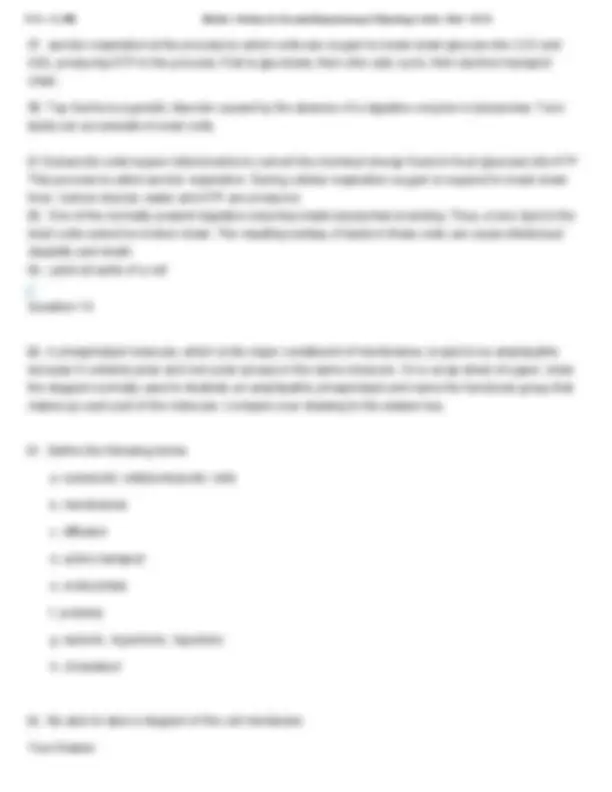Download Module 1: Problem Set: Essential Human Anatomy & Physiology I w/Lab - Burtt - 2025E. and more Quizzes Human Physiology in PDF only on Docsity!
Module 1: Problem Set
Due No due date Points 5 Questions 15 Time Limit None
Instructions
Notice: To optimize your learning in this course, we advise that you complete the labs and modules as indicated in the BIOD 151 Lab Schedule. Please be familiar with all bold face words in the module. In addition, below are some review questions that will be helpful. This is not an exhaustive list of review questions. It is a general list of possible topics that could be on the exam.
Attempt History
Attempt Time Score LATEST Attempt 1 833 minutes 5 out of 5 Score for this quiz: 5 out of 5 Submitted May 28 at 12:56pm This attempt took 833 minutes. Question 1
- There six levels of organization of the body- what are they?
- The necessary life function that protects our internal environment from our external environment is provided by what system?
- The function of movement is provided by what system?
- The function of responsiveness is provided by what system?
- The function of digestion is provided by what system?
Your Answer:
- The six levels of organization of the bod includes the following: Chemical, Cellular, Tissue, Organ, Organ system, and Organism.
- The Integumentary system (hair, skin, nails) protects our internal environment from our external environment.
- The muscular system is provides the function of movement.
- The nervous system is responsible for our body's responsiveness.
- Digestion is provided by the digestive system.
- chemical level, cellular level, tissue level, organ level, organ system level, organism level.
- Integumentary
- muscular
- Nervous
- Digestive Question 2
- What is anabolism?
- What is catabolism?
- Excretion involves what systems?
- The reproductive system is controlled by what other system?
- Which tissue covers the body surface and lines the cavities of the body. Your Answer:
- Anabolism is the process of building up molecules from simple ones. For instance amino acid to protein. It requires energy and is involved in growth, repair and synthesis within the body.
- Glycolysis, Citric Acid Cycle, Electron transport system
- ATP is a very energy rich molecule the powers the cellular activities allowing cells to have the energy needed to carry out their functions.
- The cells that make up epithelial tissue are specialized for tasks such as secretion and absorption. These cells are under constant cell division to replace dead cells that shed away.
- The four basic tissue types in the human body are epithelium, muscle, connective and nervous tissue, each of which is made up of specific cell types that perform specific functions.
- See module Question 4
- Toward or at the body surface is known as what direction?
- Away from the body surface is what direction?
- Between a more medial and more lateral structure is what orientation?
- Toward or at the midline of the body or on the inner side of is what direction?
- Away from the head end or toward the lower part of a structure of the body, is what direction? Your Answer:
- Superficial
- Deep
- Intermediate
- Medial
- Inferior
- superficial
- deep
- intermediate
- medial
- inferior Question 5
- Toward the head end or upper part of a structure (above) is what direction?
- Toward or at the front of the body is what direction?
- Is the knee proximal or distal to the pelvis?
- Is the elbow proximal or distal to the hand?
- Toward or at the back of the body is what direction? Your Answer:
- Superior/Cranial
- Anterior/Ventral
- Distal
- Proximal
- Posterior/Dorsal
- superior
- ventral (anterior)
- distal
- proximal
- Dorsal (posterior)
- Look at the figure below of the right elbow. What is the demonstrated action (in the direction of the arrow)?
- Look at the figure below of the right hand. A person standing in anatomical position moves their right wrist laterally towards the radius. What is this action called (towards label A)?
- Axial division
- Sagittal
- Frontal
- Superior and Inferior
- Oblique Question 9
- This body cavity protects the nervous system.
- This body cavity encases the brain.
- This cavity encloses the spinal cord.
- The frontal plane is also known as the plane.
- The ventral body cavity is divided into these two cavities: Your Answer:
- Dorsal body cavity
- cranial cavity
- vertebral spinal cavity
- coronal plane 43 thoracic cavity abdominopelvic cavity
- Dorsal body cavity
- Cranial
- Spinal
- Coronal
- Thoracic and abdominopelvic
Question 10
- This cavity encloses the heart:
- The outer surfaces of the organs and body cavities are covered by this double layered membrane called the
- What is pleurisy?
- The abdominopelvic region is divided into what four quadrants?
- This region surrounds the naval Your Answer:
- pericardial cavity
- serous membrane
- Pleurisy is inflammation of the pleura, the membrane surrounding the lungs, causes pain when breathing. the pleura is suppose to minimize friction of moving parts.
- Right upper quadrant, left upper, right lower, left lower
- umbilical region
- pericardial
- Serosa
- Inflammation of the pleurae.
- Right upper, Left upper, Right lower and Left lower.
- Umbilical Question 11
- This region houses the pelvis.
b. ribosomes c. smooth ER d. rough ER e. RNA f. endospore g. Golgi complex h. lysosome i. mitochondria j. plasma membrane k. microtubules and microfilaments l. extracellular matrix Your Answer:
- to allow for efficiency when transporting nutrients.
- prokaryotes have no true nucleus, no membrane bound organelles and a smaller. Eukaryotes have a nucleus with a membrane, membrane bound organelles and a larger.
- Nucleus controls cell activities and store dna. Ribosomes sythesis proteins. Smooth ER synthesize lipids and detoxify drugs/toxins. Rough ER processes and transports proteins made by ribosomes attached to its surface. RNA transports genetic information from dna to ribosomes (mRNA), form ribosomes (rRNA), and assemble proteins (tRNA)/ Endospores give bacteria resistance and extreme condition survival. Golgi Complex sorts and packages cell materials for delivery inside and out the cell. Lysosomes breakdown waste, damaged organelles and foreign invaders using digestive enzymes. Mitochondria produce atp through aerobic cellular respiration. The plasma membrane is a selective barrier. Microtubules and microfilaments maintains cell shape and movement. ECM provides structural support outside the cell.
- Cells need to remain relatively small because as a cell expands the amount of surface area relative to the volume of the cell decreases. The smaller cell is more active because relative to its volume its surface area is larger than a bigger cell. With a larger surface area (relative to its volume) this allows the metabolic processes to occur faster. Metabolic processes such as transportation of wastes across the membrane and diffusion can all occur at a faster rate.
- Prokaryotic cells are typically smaller than eukaryotic cells. Most are between 1-10 μm (micrometers) in size (about 1/30,000 of an inch); therefore, they are just visible with the light microscope. 2) The DNA of a prokaryotic cell is not enclosed in a nuclear membrane (prokaryotic means “before the nucleus”). 3) Prokaryotic cells do not contain many of the internal membrane-bounded organelles of eukaryotic cells.
Nucleus - contains DNA and serves as the control center of the cell. Ribosomes - tiny manufacturing plants that assemble proteins. Smooth ER - synthesizes lipids. Rough ER - modifies and transports proteins derived from the ribosomes that are found along its surface. RNA - take the coded amino acid sequence from nucleus to ribosome for protein synthesis. Endospore - dormant, extremely durable cell produced by the bacteria clostridium botulinum which can lead to botulism. Golgi complex - responsible for receiving lipids and proteins synthesized by the endoplasmic reticulum, altering their structures and shipping them to other parts of the cell. Lysosome - possess digestive enzymes which break down biomacromolecules. Mitochondria - convert the chemical energy found in food into ATP. Plasma membrane - contains specialized “pumps” and “gates” that regulate the passage of materials into and out of the cell. In prokaryotic cells the membrane folds inward to provide a place for reactions to take place. Microtubules are hollow and anchored to the MTOC; microfilaments are solid and create movement. extracellular matrix contains collagen fibers, found in human/animal cells. Question 13
- Describe aerobic respiration and the purpose of ATP production.
- Explain what happens in Tay-Sachs disease.
- Label all structures inside a cell (See figure in module) Your Answer:
- a phospholipid is amphipathic because it contains a hydrophilic and hydrophobic part.
- eukaryotic cells are complex cells found in humans and plants. Prokaryotic are simple cells found in bacteria. membranes are flexible barriers. Diffusion is passive movement. active transport uses energy to move substances against a concentration gradient. Endocytosis is a type of active transport where large molecules are engulfed by the cell, forming a vesicle. Proteins are macromolecules made of amino acids. isotonic is equal solute, hypertonic is more solute outside cell, hypotonic is less solute outside cell.
- Overview of key principles: a. eukaryotic cells/prokaryotic cells - recognize the three main differences between them (size, organelles and membranes). b. membranes - know their detailed structure (including hydrophobic and hydrophilic regions of proteins, phospholipids and cholesterol). Understand the importance of membranes in being able to separate or confine molecules. Know what is “fluid” about a membrane. c. diffusion - know the difference between diffusion and facilitated diffusion and know which molecules use each type and why.
d. active transport - know how this process relates to the concentration gradient and that it requires additional energy. e. endocytosis – understand the three types of endocytosis (also in the figure). Know how to describe which types of molecules use this method. f. proteins - know how proteins are used in diffusion, active transport, and the extracellular matrix. g. isotonic, hypertonic, hypotonic-know the difference in these terms and how a cell would react in different solutions (see examples in text). Remember that these terms refer to the amount of solute in an aqueous solution. Water moves into an area of high solute concentration. h. cholesterol- describe how it helps to stabilize the cell membrane. Question 15 5 / 5 pts As a reminder, the questions in this review quiz are a requirement of the course and the best way to prepare for the module exam. Did you complete all questions in their entirety and in your own words? Your Answer: yes.
Quiz Score: 5 out of 5

